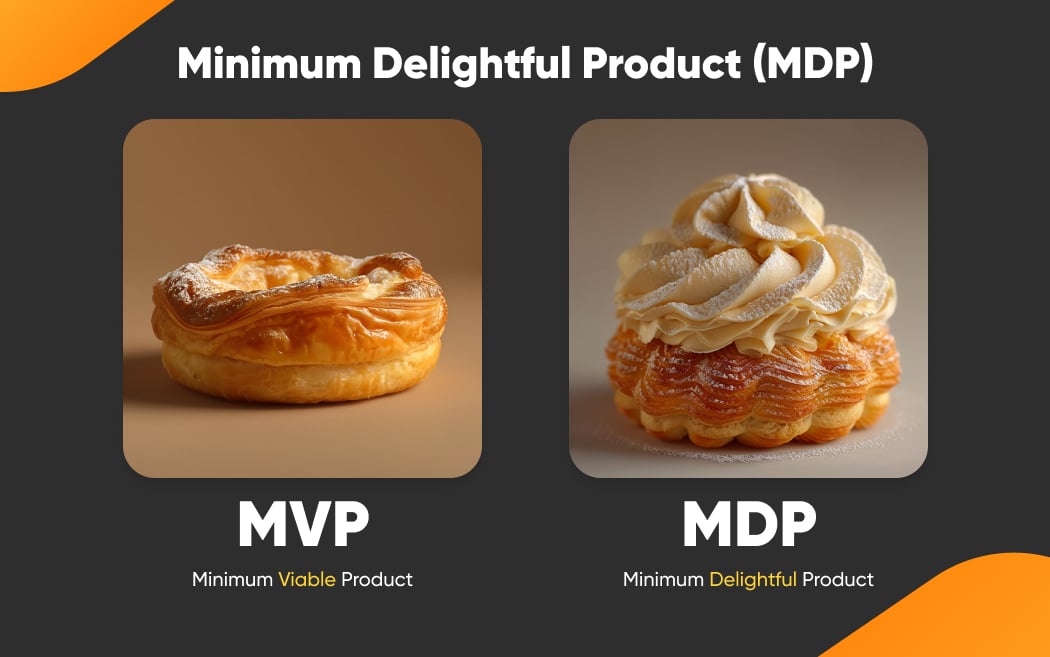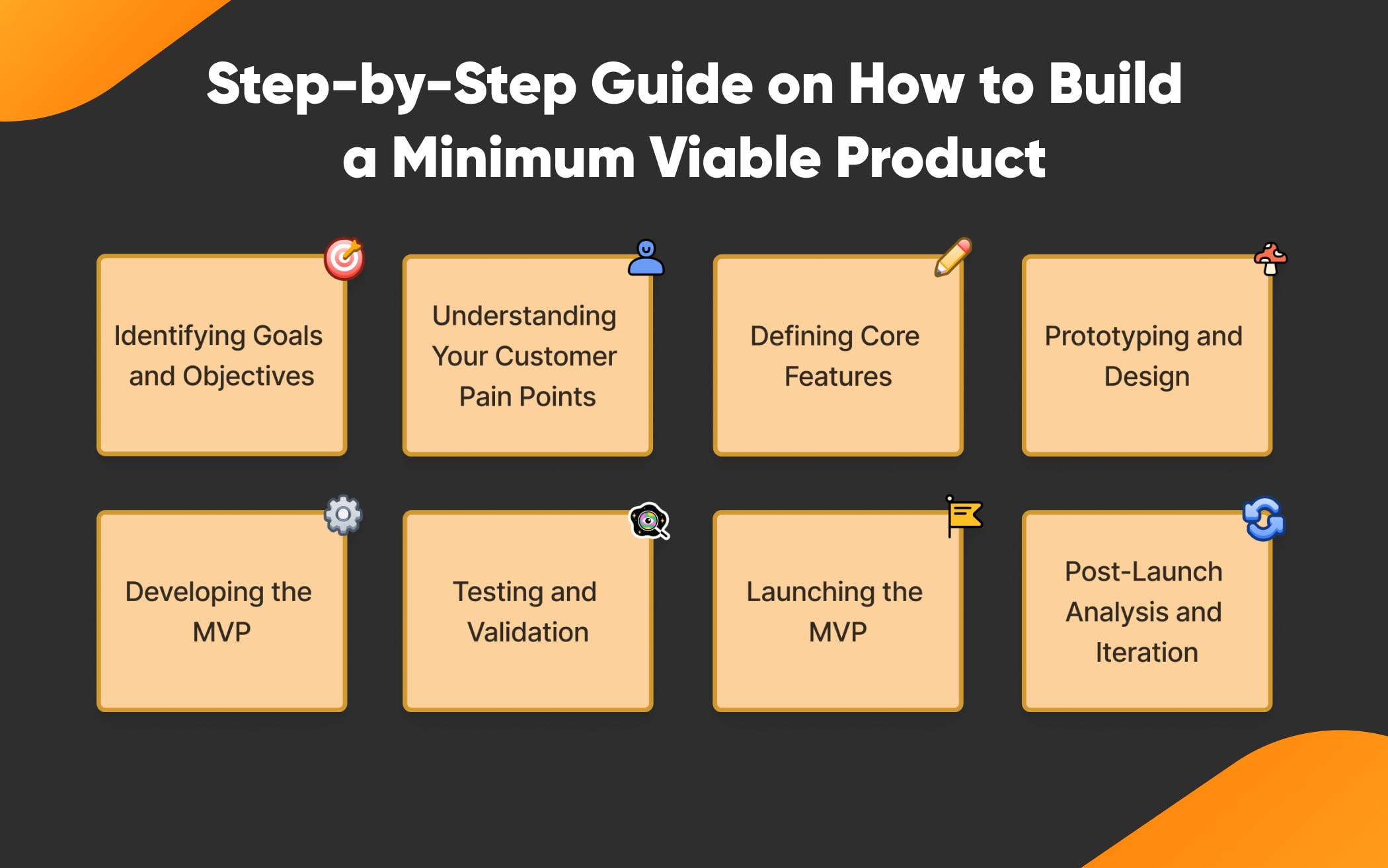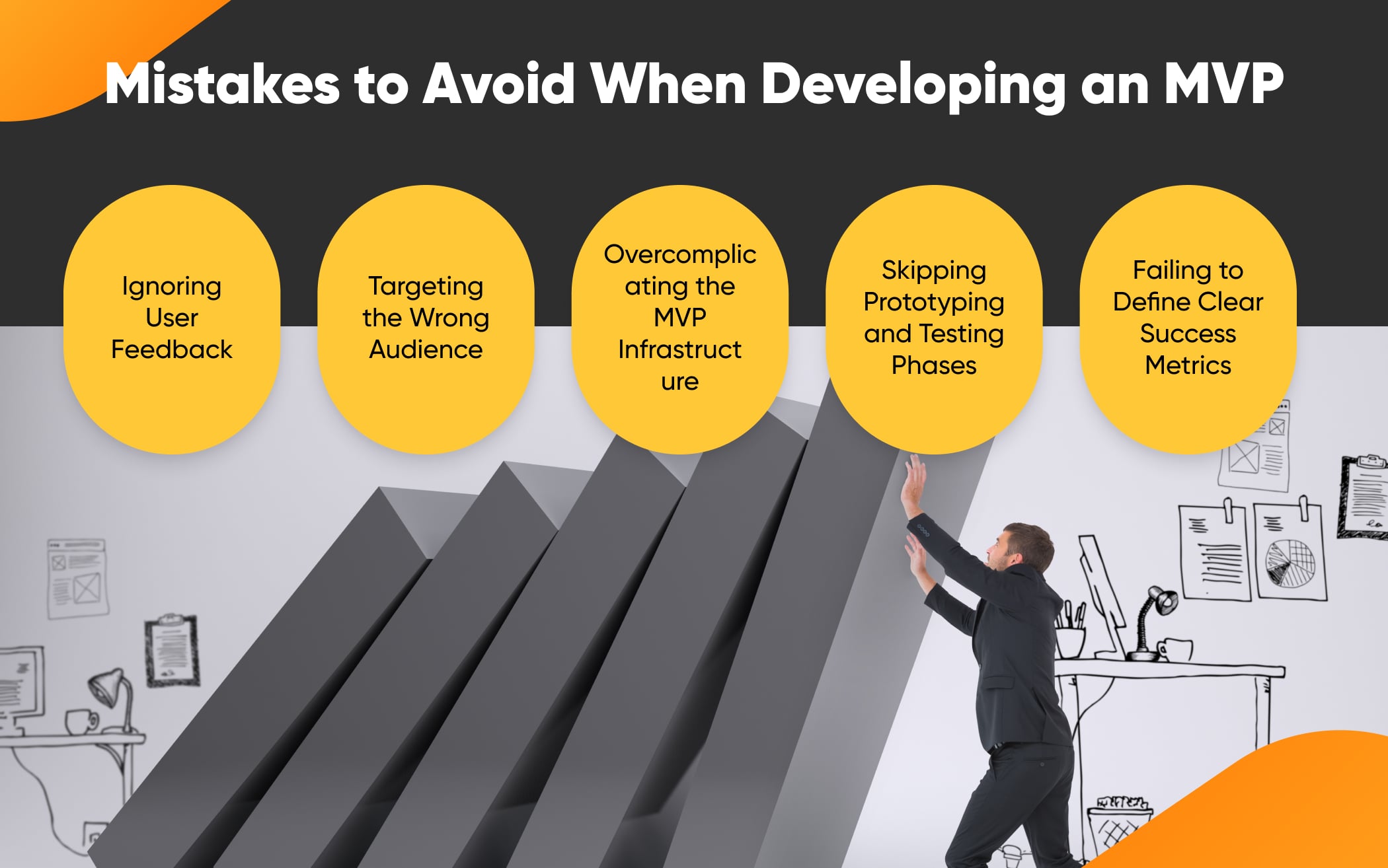Imagine it’s 2024 and you’re about to launch a fancy product in an over-saturated marketplace by spending hefty costs just to impress your customers and beat your competitors. If I may add, you must have included enticing features as well that make your app look cool but it doesn’t meet your user needs and expectations, right? After some time, you get to know there’s no market need for the product and customers aren’t willing to pay for the service you’re offering.
Ok, don’t fret anymore as that was just an imagination, not a reality though! To get around this nightmare, there exists an amazing approach abbreviated as MVP (Minimum Viable Product.) Curious to learn about what an MVP is and how you can build a minimum viable product for your startup? Continue reading this guide as we’ll be dripping the secret recipe to successfully developing and launching your MVP using the agile development methodology.
Key Takeaways
- A Minimum Viable Product (MVP) is an early version of a product with just enough features to satisfy early adopters and gather feedback for future development.
- A Minimum Delightful Product (MDP) goes beyond the MVP by not only addressing core user needs but also incorporating elements that delight users, providing an exceptional and engaging user experience from the outset.
- An MDP approach to MVP helps create a more user-centric product, leading to higher user engagement and satisfaction.
- In MVP development, Agile emphasizes iterative progress, frequent releases, and continuous user feedback.
Table of Content
What is a Minimum Viable Product?

Simply put, an MVP is a mini version of the product launched to the market with only core features to check whether the product has enough demand, is viable, solves real-world problems, addresses target audience pain points, and meets user expectations with the least amount of effort, resources, and time.
The main focus is to attract early adopters who use your product and provide genuine feedback if your product has captured and fulfilled their needs. The product goes through several iterations before it turns into a final product. Should you consider building a minimum viable product?
- When you need to test and build a new product idea based on validation rather than assumptions
- Your budget and resources are limited.
- When you want to speed up your time-to-market to launch a product earlier.
- You want to attract early adopters and gain user feedback
What’s the Major Challenge with Today’s MVP?
The major challenge with today’s MVP development is that today’s slick product design and modern user experience (UX) have made users crave a delightful app experience, regardless of whether the app is a mini version or a fully-featured product. So, what do you need to consider to ensure your MVP not only meets basic functionality but also provides an engaging and delightful user experience? Go for a Minimum Delightful Product (MDP).
Minimum Delightful Product (MDP)

Like MVP, a minimum delightful product is an early version of a product that works like a charm by focusing on delighting and engaging users. It combines essential functionality with thoughtful design and emotional engagement to ensure the product isn’t just functional but also loveable by end-users. The MDP aims to provide a satisfying and enjoyable user experience from the beginning.
You can also achieve a competitive advantage for your business if you opt for a MDP. How? As we know the user experience is one of the major aspects of app development, nothing can beat your product that delivers a great user experience. Moreover, users will be more likely to adopt, utilize, and share your minimum viable product if they really enjoy using it rather than just tolerating it.
Here you need to understand that creating a delightful experience isn’t just about working on aesthetics; rather, it’s a combination of functionality that provokes positive emotions, seamless usability, and meaningful interactions at every stage of a user journey. So, it could be an easy-to-navigate interface, an effortless onboarding experience, the simplicity of accessing a key feature, or something unique that makes your users fall in love with your MVP.
Nonetheless, the answer to how to build a minimum viable product is to create a minimum delightful product that is both viable and appealing from the start.
Benefits of Agile MVP Development

Before moving towards the steps to building an MVP, there is one more thing needs to be discussed here: what development methodology MVP owners need to follow. There are many development methodologies, but the best suited for MVP development is Agile. It’s because MVP is of an iterative nature and focuses on rapid development and feedback. An MVP developed using agile methodology typically enhances flexibility and responsiveness to user feedback.
You and your development team follow these practices in agile MVP development:
- Maintain a backlog of all your potential MVP features.
- Select high-priority features that your team aims to implement in consecutive biweekly intervals.
- Monitor the progress of your MVP and adjust each subsequent sprint based on the outcomes achieved from the previous one.
- Your team delivers intermediate results after each sprint.
- Enhance the development process’s speed and effectiveness based on performance evaluations from each sprint.
What are the benefits of utilizing the agile approach to building a minimum viable product?
- Faster Time-to-Market: Agile MVP development allows you to quickly release your MVP, enabling early market entry and immediate feedback.
- Cost Efficiency: By focusing only on essential features, Agile MVP development lets you minimize wasted resources and reduces overall development costs.
- User-Centric Development: With agile, you can focus on the incorporation of continuous user feedback throughout the development process to ensure the final product meets your user’s needs and preferences.
- Flexibility and Adaptability: Agile methodologies enable your team to pivot and make changes based on real-time feedback and market demands to improve responsiveness.
- Reduced Risk: You can regularly test your MVP and reduce the risk of major failures by identifying and addressing issues early in the development cycle.
- Data-Driven Decisions: Early and ongoing user feedback provides valuable insights that allow for data-driven decision-making and strategic planning.
- Scalability: You can expand and scale your minimum viable product with new features and functionalities based on user demand and feedback using Agile.
Step-by-Step Guide on How to Build a Minimum Viable Product

Below we’ve outlined the step-by-step guide that helps you understand how to build a minimum viable product and of course delightful as well. Let’s get started:
1. Identifying Goals and Objectives
When developing your MVP, the first step you need to take is identifying clear goals and objectives. Think about what you want to achieve with your MVP and set specific, measurable targets. Are you aiming to validate a new product idea, attract early adopters, or test specific features? Defining your goals will guide your development process and help you measure success. Without clear objectives, you might find yourself lost in the development process without a clear direction.
2. Understanding Your Customer Pain Points
Without in-depth research about your customers, you cannot build a minimum viable product that delights them. For this purpose, you must have a thorough understanding of the pain points your target audience faces, what solutions they currently rely on that resonate with yours, and whether they find it interesting or delightful to use or if they had a bad experience using it. At this point, you also need to research your competitors and identify any shortcomings that you can address within your MVP to gain a competitive edge and offer a unique value proposition. This phase is crucial because it informs you about what your potential users truly need and want.
3. Defining Core Features
Once you’ve defined your goals, identified your user pain points, and understood your market, it’s time to identify the core features of your MVP. Here, you need to remember that you are going to build an MDP, so you need to go the extra mile to strike the right balance between delivering core functionality with a touch of delight while ensuring it solves the primary problems of your users.
Let’s see how you can achieve this:
- Core Functionality: First and foremost, your MVP should nail the basics. It needs to deliver the essential features that effectively solve your users’ pain points. Think of it as the backbone of your product.
- User-Centric Design: If you want to delight users, you should not miss out on building a user-centric MVP. It helps you focus on your user’s needs and pain points through a constant feedback mechanism.
- Personalization: Everyone loves a personal touch. Offer some level of customization to meet individual user preferences. This makes your users feel valued and catered to.
- Smooth Onboarding Experience: To introduce your product to customers and help them understand how to use it, it’s essential to build a great onboarding process. It will help your customers quickly adopt your product.
- Usability and Accessibility: Focus on ensuring that your product is easy to use. This includes clear instructions, logical workflows, and accessibility features that make the product usable for a wide range of users. Usability is key to keeping users engaged and satisfied.
- Consistency: Today users use different touch points to interact with a product or service. So, it’s essential to deliver a consistent user experience across all touchpoints to ensure users feel comfortable and confident in using your product.
Remember when you build an MDP you don’t just need to think about specific features, you need to go the extra mile to ensure you offer incredible customer service, unbeatable support, and smooth onboarding that brings true joy and satisfaction to your customers.
4. Prototyping and Design
This is the most important phase of MVP development where you map out the user journey and information architecture. You first prepare rough draft (low fidelity) wireframes without focusing on adding aesthetics or details and then proceed to create a high-fidelity prototype. These are tangible/interactive prototypes that showcase both the core functionality and delightful features of your product to get feedback from potential users. This phase allows you to visualize how your MVP will look and function, making adjustments before committing to full-scale development. Prototyping helps catch potential issues early and refines your product vision.
5. Developing the MVP
With a solid prototype and design in hand, you can move on to developing the MVP. Choose a development approach that allows for flexibility and iteration, such as Agile methodology. Develop the core features you’ve defined, and ensure that the product is functional and meets the basic needs of your users. Collaboration among your team is key during this phase to stay aligned and maintain focus on delivering the MVP quickly.
6. Testing and Validation
Once your MVP is developed, testing and validation are crucial steps. Test the product thoroughly to identify and fix any bugs and usability issues. Validation involves getting your MVP in front of real users to gather feedback. This step ensures that your product works as intended and meets user expectations as well as keeps them delightful. Testing and validation help you refine the MVP and reduce the risk of significant problems.
7. Launching the MVP
When your MVP is tested and validated, it’s time to launch it. Prepare a launch strategy that targets your early adopters and generates initial traction. Use marketing channels to effectively reach your target audience and communicate the value of your MVP. The launch phase is your opportunity to showcase your product to the world and start gathering real-world feedback. Make sure your launch is well-planned and executed.
8. Post-Launch Analysis and Iteration
The work doesn’t stop after the launch. Post-launch analysis and iteration are critical for the ongoing success of your MVP. Collect data on user behavior, engagement, and feedback. Analyze this data to understand how your product is performing and where improvements can be made. Use this information to iterate on your MVP, adding new features or refining existing ones based on user needs and market trends. Continuous improvement ensures that your product remains relevant and valuable to users.
5 Mistakes to Avoid When Developing an MVP

1. Overcomplicating the MVP Infrastructure
According to Forbes, one of the major problems why startups fail is that they overbuild their MVP infrastructure. An MVP is meant to validate the basic concept with minimal investment. Overloading it with features increases your development time and costs, and also causes delays in entering the market. To avoid this, you must focus on only the core features to address your user needs and provide value to early adopters while keeping the MVP simple and delightful.
2. Ignoring User Feedback
User feedback is crucial for refining and improving the MVP. Ignoring this feedback means you miss out on valuable insights that can enhance your product. This oversight can lead to poor user satisfaction and low adoption rates, as the product may not meet user needs or expectations. Actively analyze user feedback and make necessary adjustments based on this data to ensure your MVP evolves in line with user preferences.
3. Failing to Define Clear Success Metrics
Without specific, measurable goals, it becomes challenging for you to evaluate your MVP’s performance and determine whether it meets your defined objectives. Therefore, the best practice is to establish clear success metrics from the outset—such as user engagement, retention rates, or conversion goals that provide a benchmark for success and inform data-driven decisions.
4. Skipping Prototyping and Testing Phases
If you rush to launch your MVP without adequate prototyping and testing, it can lead to significant issues post-launch. This can result in a subpar user experience and potential product failures. Prototyping and testing help you identify and resolve issues early. So, allocate sufficient time and resources for this phase to refine your product and overcome critical problems before the MVP reaches the market.
5. Targeting the Wrong Audience
You must test your MVP with the right audience—early adopters who are likely to be the most engaged with your product and provide the most insightful feedback. Failing to identify and target this audience can lead to irrelevant feedback and poor adoption rates. Conduct thorough market research to understand who your early adopters are and tailor your marketing and outreach efforts to reach this critical group.
Build Your MVPs with Cygnis Media- The Leading MVP Development Company
If you’re looking for the best MVP development company that helps you build a delightful, highly usable, and cost-effective mini version of your full-fledged ideal app then connect with Cygnis Media. We understand how important it is to test and validate your product or app idea before investing a significant resource in building it.
For this purpose, we carefully understand your exact business needs, carry out extensive user research, and list down features- of course, the essential ones that solve real user problems while ensuring they delight and please your target audience. What else we do is build basic MVP prototypes to get early user feedback and avoid costly mistakes at any cost. We also adapt to the agile development methodology to quickly iterate your initial product based on real-user feedback, evolving user needs, and faster time-to-market. Sounds interesting, right? Get in touch with our expert MVP consultant today to embark on a delightful MVP development journey.
Conclusion
In summary, startup owners or entrepreneurs who want to launch a new product must consider developing an MVP to validate their idea quickly. It helps them test a new market, operate within a limited budget, accelerate their time-to-market, and gather early user feedback. However, as we discussed earlier how users demand a more smooth user experience, it’s crucial to implement it in a way that is delightful to them using the MDP approach. MDP is also the mini version of the product that along with core functionalities focuses on making the MVP delightful for users. MDP is adopted faster, retains the user, and delivers a positive first impression. Go, and make delightful MVPs that are usable, accessible, and functional.











